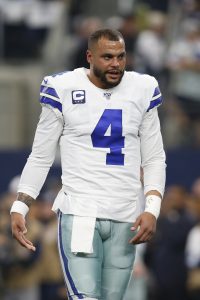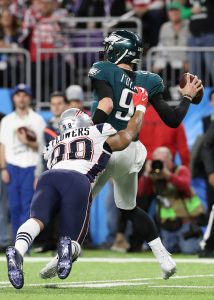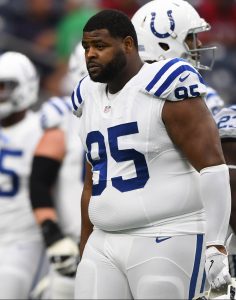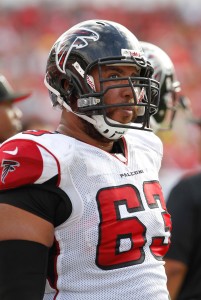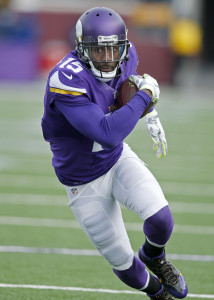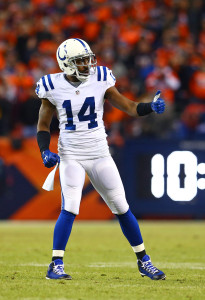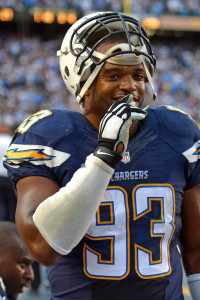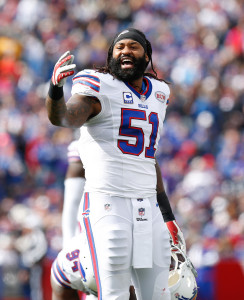While teams will surely apply the franchise tag to a number of the best pass rushers on the market, one has seemed to receive much less buzz than warranted. 49ers defensive lineman Arik Armstead failed to live up to his first-round selection early in his career but has quietly become a difference-maker along the San Francisco front four.
In free agency rankings and previews Jadeveon Clowney, Shaquil Barrett, and Yannick Ngakoue have 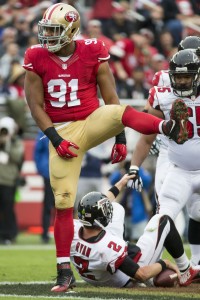 all consistently ranked ahead of the 17th overall selection in the 2015 Draft. However, there is a pretty compelling argument that Armstead is the best player of the bunch.
all consistently ranked ahead of the 17th overall selection in the 2015 Draft. However, there is a pretty compelling argument that Armstead is the best player of the bunch.
Few experts would argue that Armstead wasn’t the most productive of the group last season. Per Pro Football Focus (PFF), Armstead was the 6th highest graded edge defender last season of the 107 qualified players. Clowney ranked 20th, Barrett ranked 25th, and Ngakoue ranked 36th. Barrett accrued a league-leading 19.5 sacks (Armstead recorded 10, Ngakoue had 8, and Clowney just 3), but recorded fewer hurries than Armstead, which tend to be more predictive of future sack production.
It seems that most experts view Armstead as a one-hit-wonder, only producing in his contract year, but the evidence is a bit more complicated. With the exception of the 2016 season (when he missed 8 games with injury), Armstead has always graded out by PFF as a solid defensive lineman (receiving grades of 79.0, 70.1, and 74.8 in 2015, 2017, and 2018) who was particularly effective against the run. There’s no denying that Armstead reached another level of productivity in 2019, but it appears a bit disingenuous to say it came entirely out of nowhere.
Most impressive of all, even as Armstead built his reputation on run-stopping ability, he has generated hurries at the greatest rate of the group, not in 2019, but over his entire career. Armstead has generated a hurry on over 9.2% of his pass-rush snaps over his career, according to PFF, none of the other three have surpassed 7.8%.
Of course, the 49ers have been especially baron along the defensive line (aside from DeForest Buckner) for most of Armstead’s career. Obviously the additions of Nick Bosa and Dee Ford this offseason turned one of the team’s previous weaknesses into its greatest strength. But, some evaluators attribute Armstead’s jump to the improvement in his teammates more than a true change in him as a player.
Injuries, which were problems for Armstead in his second and third NFL seasons, have been a nonfactor over the previous two seasons and especially this season-when he played on 912 snaps between the regular season and playoffs as a part of the 49ers NFC Championship run.
At just 26 years of age, Armstead, an Oregon alum, appears poised to enter his prime of productivity, but will the market view him that way? Or will teams remain skeptical that his elite production in 2019 is sustainable without an elite supporting cast alongside him?
The top of the market for a player like Armstead would likely approach Frank Clark‘s 5-year, $104MM contract with the Chiefs last offseason, on the flipside, Armstead’s floor is probably around his teammate Dee Ford‘s 4-year, $85MM deal. Reports have suggested the 49ers want to resign Armstead, but limited on cap space following their Super Bowl loss to Kansas City, the team will have to shuffle some money around to make a new deal feasible (ironically, a new deal for Armstead could result in the release or trade of Ford).
If they are unable to resign him, San Francisco, already short of draft capital, could very likely recoup a strong return for Armstead via a tag-and-trade move, but the team would need to clear the necessary cap space to apply the franchise tag before they made any move.
Since most focus remains on Clowney, Ngakoue, and Barrett, few rumors have tied Armstead to any other teams, but don’t be surprised if teams seem to evaluate Armstead at the same level (or maybe even above) some of the other options.
